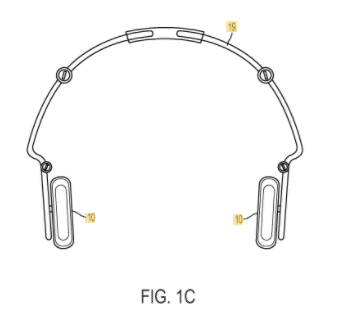Wireless earphone set
An earphone set that comprises a paired set of earphones to be worn simultaneously by a user is
disclosed. Each earphone in the paired set comprises at least one acoustic transducer for producing sound to be
heard by the user. At least one of the earphones in the pair set comprises a transceiver circuit and at least one
button. The transceiver circuit is for wirelessly receiving and transmitting signals via a wireless network. The at
least one button is accessible to the user at an exterior of the at least one earphone. Upon activation of the at
least one button by the user, an indication for a song played by the pair of earphones is caused to be transmitted
wirelessly, by the transceiver circuit via the wireless network, to a remote server connected to the Internet. The
song played by the pair of earphones may be streamed from a digital audio content server connected to the Internet.
BACKGROUND
Digital audio players, such as MP3 players and iPods, that store and play digital audio files, are very popular. Such
devices typically comprise a data storage unit for storing and playing the digital audio, and a headphone set that
connects to the data storage unit, usually with a ¼″ or a 3.5 mm jack and associated cord. Often the headphones are
in-ear type headphones. The cord, however, between the headphones and the data storage unit can be cumbersome and
annoying to users, and the length of the cord limits the physical distance between the data storage unit and the
headphones. Accordingly, some cordless headphones have been proposed, such as the Monster iFreePlay cordless headphones
from Apple Inc., which include a docking port on one of the earphones that can connect directly to an iPod Shuffle.
Because they have the docking port, however, the Monster iFreePlay cordless headphones from Apple are quite large and
are not in-ear type phones. Recently, cordless headphones that connect wirelessly via IEEE 802.11 to a WLAN-ready laptop
or personal computer (PC) have been proposed, but such headphones are also quite large and not in-ear type phones.
In one general aspect, the present invention is directed to a wireless earphone that comprises a transceiver circuit for
receiving streaming audio from a data source, such as a digital audio player or a computer, over an ad hoc wireless
network. When the data source and the earphone are out of range via the ad hoc wireless network, they may transition
automatically to a common infrastructure wireless network (e.g., a wireless LAN). If there is no common infrastructure
wireless network for both the data source and the earphone, the earphone may connect via an available infrastructure
wireless network to a host server. The host server may, for example, broadcast streaming audio to the earphone and/or
transmit to the earphone a network address (e.g., an Internet Protocol (IP) address) for a network-connected content
server that streams digital audio. The earphone may then connect to the content server using the IP address. The content
server may be an Internet radio server, including, for example, an Internet radio server that broadcasts streaming audio
from the data source or some other content.

In another general aspect, the present invention is directed to a system comprising a wireless earphone set and a client
computing device, both of which are communicable with a host server via the Internet. The host server stores
configuration parameters for the wireless earphone set that are transmittable to the wireless earphone set via the
Internet, and that are configurable by an authenticated user of the client computing device via the host server to
generate updated configuration parameters for the wireless earphone set. The updated configuration parameters for the
wireless earphone set are transmitted by the host server to the wireless earphone set via the Internet.
In another general aspect, the present invention is directed to an earphone set that comprises a paired set of earphones
to be worn simultaneously by a user. Each earphone in the paired set comprises at least one acoustic transducer for
producing sound to be heard by the user. In addition, at least one of the earphones in the pair set comprises a
transceiver circuit and at least one button. The transceiver circuit is for wirelessly receiving and transmitting
signals via a wireless network. The at least one button is accessible to the user at an exterior of the at least one
earphone. Upon activation of the at least one button by the user, an indication for a song played by the pair of
earphones is caused to be transmitted wirelessly, by the transceiver circuit via the wireless network, to a remote
server connected to the Internet. In various implementations, the song played by the pair of earphones is streamed from
a digital audio content server connected to the Internet.
Background:
Digital audio players, such as MP3 players and iPods, that store and play digital audio files, are very popular. Such
devices typically comprise a data storage unit for storing and playing the digital audio, and a headphone set that
connects to the data storage unit, usually with a ¼″ or a 3.5 mm jack and associated cord. Often the headphones are
in-ear type headphones. The cord, however, between the headphones and the data storage unit can be cumbersome and
annoying to users, and the length of the cord limits the physical distance between the data storage unit and the
headphones. Accordingly, some cordless headphones have been proposed, such as the Monster iFreePlay cordless headphones
from Apple Inc., which include a docking port on one of the earphones that can connect directly to an iPod Shuffle.
Because they have the docking port, however, the Monster iFreePlay cordless headphones from Apple are quite large and
are not in-ear type phones. Recently, cordless headphones that connect wirelessly via IEEE 802.11 to a WLAN-ready laptop
or personal computer (PC) have been proposed, but such headphones are also quite large and not in-ear type phones.